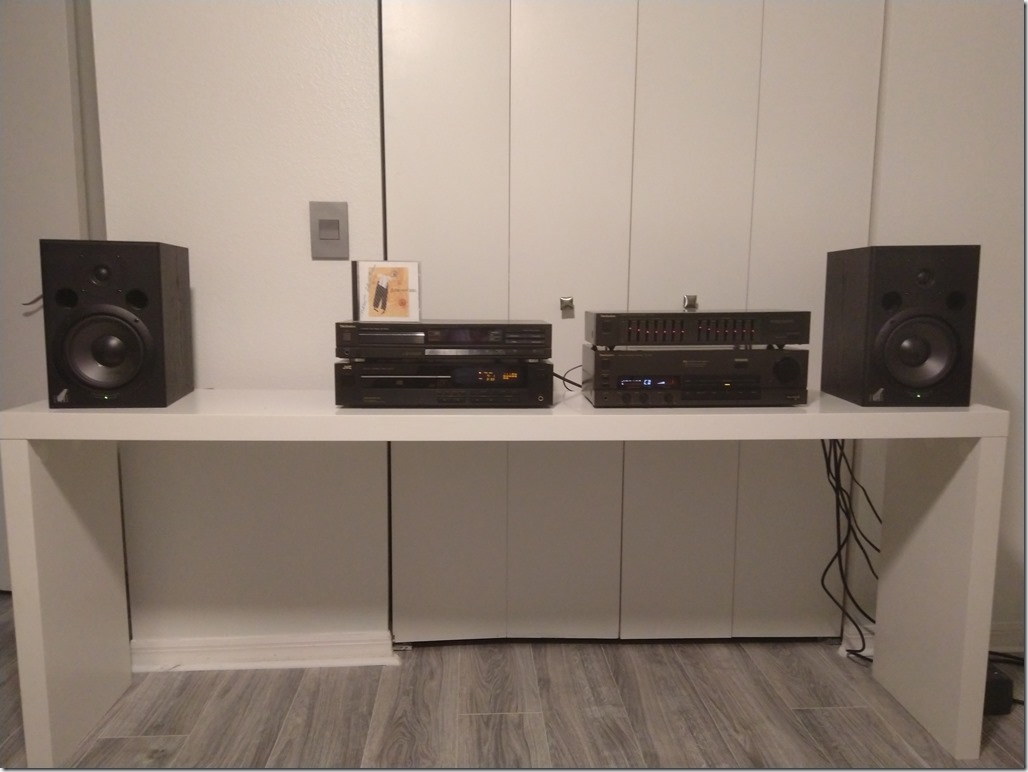Being cooped up in the house with the COVID stay-the-fuck-at-home orders has led me to express my shopping needs in other ways. The subject at hand is my stereo system. An earlier post reminded me that I’ve had this goal to recapture the stereo excitement of my youth for quite a few years now. And that’s not to say progress hasn’t been made – it definitely has.

It started with a cheap thrift store stereo, a tape deck, and headphones. Then a CD player was added. Then another CD player was added. But still, very little listening was being done. Then the milestone of having a dedicated room for listening was reached and I cobbled a new and different stereo system together using my powered studio monitors and a new preamplifier to handle inputs and volume. A dedicated listening chair completed the arrangement. This setup has worked very well for over a year.

But I’ve been envisioning the real stereo experience, with a powerful amplifier and full-size speakers to go with it. However, in these uncertain times, I don’t want to blow a wad of cash all at once, so I’ve planned out a phased approach to get there relatively quickly.
The primary hardware to complete the goal is really only two items: the amplifier and the speakers. There’s also some ancillary bits as well, including furniture for the hardware. I’ve kind of been stalled on progress because I didn’t want to buy the amp and the speakers all in one go, but I didn’t want to buy either one and just have it sit unused until I bought the other. Then, I had a revelation, which came late, but probably at a better time.
If I buy an amplifier, it would be a waste until I bought my speakers, because my existing speakers have built in amplifiers without any way to bypass them. My revelation made me realize that although the amplification in my speakers can’t be bypassed, the amplifier circuit in the right model of amplifier could be. That would reduce the amplifier to only preamplifier functions, just like the preamplifier I currently own.
The search was then on for a receiver that had preamp outputs on it. And the critical decision needed to be made: do I go vintage or modern? In my original plan, I had current, modern products picked out and a pretty large budget for them. And now, after experiencing a number of vintage CD players, I’m not sure I need anything more modern than them. So vintage it is. And in keeping with my nostalgia, I’m going to choose the Technics brand. Justly or no, Technics has a bad reputation for their 80’s gear. There are fans out there as well, but they get shut down often by "the ones who know better".
The model I picked was the SU-V98, which has the required preamp outputs and will also be suitable for my future speakers with 110 watts per channel. That’s actually pretty respectable as many of the amps I had been looking at were 30-50. As luck would have it, a listing just popped up on EBay selling one for $70. Others were priced in the $150 range, so the purchase was made. Step one complete.

Now, the last step in the transition will be the purchase of the speakers. I’ll be able to run everything right the way I have it now, simply substituting my preamp for this new Technics amplifier. But, it’s not going to be a viable long-term option. See, my stereo setup is on a long Ikea table. Ikea stuff isn’t known for its durability and even with only a couple of CD players sitting in the middle of the span, I can see the slightest bit of sagging happening. Adding a 15lb amp to the table isn’t going to make that any better. So step two in the mid-term is going to be new furniture.
Replacing the Ikea table will require a new stereo rack and stands for the studio monitors. In the final stage, the studio monitors and stands will be replaced with tower speakers. Since the speaker stands are only temporary, I can skimp out on them, but I should get the stereo rack with the goal of having it be suitable for the future. However, when shopping for speaker stands, there is a clear distinction between "good" and "good enough". That difference is the size of the mounting plate on top. In most all affordable stands, that plate is 5"x5". My speakers are about 8"x10". Balancing those heavy, expensive speakers on a tiny platform 32 inches off the ground doesn’t sound appealing to me, especially with cats in the house.
That alters my plans a little bit. It essentially doubles the budget for the speaker stands. But, to remain positive, the stand quality will be excellent and the speakers are already excellent, so there won’t be any unnatural need to rush to the last step and buy the tower speakers. There will be time to enjoy and appreciate the configuration as it is.
And that’s really the plan: to enjoy the upgrade journey. Sometimes when you get the end result all at once, you can’t appreciate al the elements involved, because you have no history of change to compare it to. This is really the best way to grow a stereo system. Will it ever end? For a lot of people, it never does. In fact, I do know one more step I can take after "the last step". If I find my amplifier doesn’t sound as good as I think it could, the preamp outputs in the SU-V98 can be used for what they were designed for – running an external amplifier.
Comments are closed.